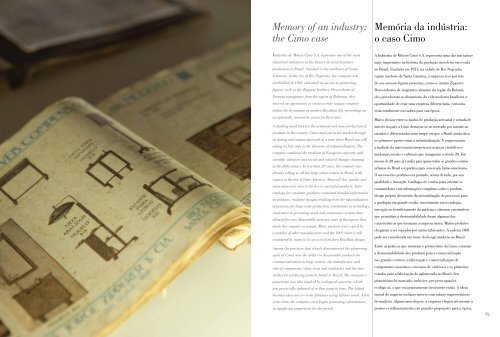Curitiba - Centro Brasil Design
Curitiba - Centro Brasil Design
Curitiba - Centro Brasil Design
You also want an ePaper? Increase the reach of your titles
YUMPU automatically turns print PDFs into web optimized ePapers that Google loves.
Memory of an industry:<br />
the Cimo case<br />
Indústria de Móveis Cimo S.A. represents one of the most<br />
important initiatives in the history of serial furniture<br />
production in Brazil. Situated in the northeast of Santa<br />
Catarina, in the city of Rio Negrinho, the company was<br />
established in 1921 and owed its success to pioneering<br />
figures, such as the Zipperer brothers. Descendants of<br />
German immigrants from the region of Bohemia, they<br />
noticed an opportunity to create a truly unique company<br />
within the dynamism of modern Brazilian life, presenting an<br />
exceptionally innovative vision for their time.<br />
A dividing mark between the artisanal and mass production of<br />
furniture in the country, Cimo stood out in the market through<br />
its daring and unique approach at a time when Brazil was still<br />
taking its first steps in the direction of industrialization. The<br />
company combined the tradition of European carpentry with<br />
scientific advances and social and cultural changes dawning<br />
in the 20th century. In less than 20 years, the company was<br />
already selling to all the large urban centers in Brazil, with<br />
exports to the rest of Latin America. Above all else, quality and<br />
innovation were seen as the key to successful products. Sales<br />
catalogs for consumer guidance contained detailed information<br />
on products, exclusive designs resulting from the rationalization<br />
of processes for large scale production, investments in technology,<br />
innovation in processing wood and constructive systems that<br />
allowed for easy disassembly were just some of the aspects that<br />
made the company so unique. Many products were copied by<br />
a number of other manufacturers and the 1001 chair is still<br />
considered by many to be an icon of modern Brazilian design.<br />
Among the practices that clearly demonstrated the pioneering<br />
spirit of Cimo, was the ability to disassemble products for<br />
commercialization in large centers, the manufacture and<br />
sale of components (chair seats and seatbacks) and the first<br />
studies for producing particle board in Brazil. The company’s<br />
pioneerism was also marked by ecological concerns, which<br />
was practically unheard of at that point in time. The initial<br />
business idea was to create furniture using leftover wood. A few<br />
years later, the company even began promoting reforestation,<br />
Memória da indústria:<br />
o caso Cimo<br />
A Indústria de Móveis Cimo S.A. representa uma das iniciativas<br />
mais importantes na história da produção moveleira em escala<br />
no <strong>Brasil</strong>. Fundada em 1921, na cidade de Rio Negrinho,<br />
região nordeste de Santa Catarina, a empresa teve por trás<br />
de seu sucesso figuras pioneiras, como os irmãos Zipperer.<br />
Descendentes de imigrantes alemães da região da Boêmia,<br />
eles perceberam no dinamismo da vida moderna brasileira a<br />
oportunidade de criar uma empresa diferenciada, com uma<br />
visão totalmente inovadora para sua época.<br />
Marco divisor entre os modos de produção artesanal e seriada de<br />
móveis no país, a Cimo destacou-se no mercado por iniciativas<br />
ousadas e diferenciadas num tempo em que o <strong>Brasil</strong> ainda dava<br />
os primeiros passos rumo à industrialização. A empresa uniu<br />
a tradição da marcenaria europeia aos avanços científicos e<br />
mudanças sociais e culturais que inauguram o século 20. Em<br />
menos de 20 anos já vendia para quase todos os grandes centros<br />
urbanos do <strong>Brasil</strong> e exportava para o mercado latino-americano.<br />
O sucesso dos produtos era pautado, acima de tudo, por sua<br />
qualidade e inovação. Catálogos de vendas para orientar os<br />
consumidores com informações completas sobre o produto,<br />
design próprio decorrente da racionalização de processos para<br />
a produção em grande escala, investimento em tecnologia,<br />
inovação no beneficiamento da madeira e sistemas construtivos<br />
que permitiam a desmontabilidade foram algumas das<br />
características que tornaram a empresa única. Muitos produtos<br />
chegaram a ser copiados por outros fabricantes. A cadeira 1001<br />
pode ser considerada um ícone do design moderno no <strong>Brasil</strong>.<br />
Entre as práticas que mostram o pioneirismo da Cimo, estavam<br />
a desmontabilidade dos produtos para a comercialização<br />
nos grandes centros, a fabricação e comercialização de<br />
componentes (assentos e encostos de cadeiras) e os primeiros<br />
estudos para a fabricação do aglomerado no <strong>Brasil</strong>. Seu<br />
pioneirismo foi marcado, inclusive, por preocupações<br />
ecológicas, o que era praticamente inexistente então. A ideia<br />
inicial do negócio era fazer móveis com sobras reaproveitáveis<br />
de madeira. Alguns anos depois, a empresa chegou até mesmo a<br />
in significant proportions for the period.<br />
promover reflorestamento, em grandes proporções para a época.<br />
62 63


